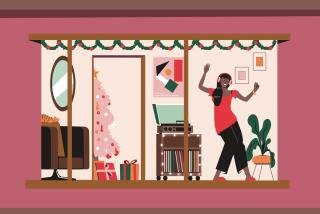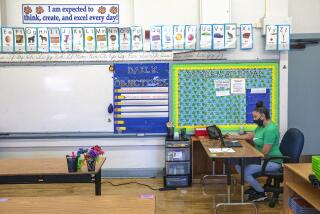Tablet computer prices just too hard to swallow
- Share via
Jessica Diaz has tablet envy.
The 30-year-old Tujunga mom sees other parents routinely handing their kids an iPad 2 or a similar device to keep them occupied at restaurants, airports and elsewhere.
“Everyone has them,” Diaz told me. “I want one.”
And this Christmas, her wish will come true. Diaz said she’ll be buying an iPad for herself and probably another for her 11-year-old son (her 5-year-old daughter will have to make do with sharing). Never mind the more than $500 cost for each device.
“It just seems like you can’t be without one these days,” Diaz said.
I know how she feels, because I too suffer from tablet envy. I’ve been watching friends and colleagues adding tablets — mostly Apple iPads — to their gadget supply, as well as other parents using the gizmos as both educational tools and entertainment resources.
Unlike Diaz, though, I won’t be buying a tablet this holiday season. Why? Two words: Price and pep.
Chronic tablet envy notwithstanding, the good ones are still too darn expensive, and the not-so-good ones are, well, not so good. Given a little more time, I’m sure, there’ll be cheaper and better tablets available. But we’re not there yet.
Even so, the allure of tablets is undeniable.
Just as the personal computer enabled ordinary folk to partake in activities once reserved for the pocket-protector set, and laptops and smartphones subsequently gave those activities legs, tablets represent the next step in technological savviness.
They’re the perfect marriage of power and portability, enabling on-the-go access to books, magazines, newspapers, music, video and the Net, all in a slick, look-how-cool-I-am package.
Market researcher IDC predicts that about 62.5 million tablets will be sold to consumers this year. That may not sound like a lot compared with the 357 million PCs expected to be sold, but the real story is in the turbo-charged pace of growth in tablet sales.
This year’s sales will be nearly 250% higher than the 18 million tablets sold last year, IDC says. PC sales, meanwhile, will increase by an anemic 3%.
And what’s especially remarkable is that tablets have become a communal item among families. About a third of tablet owners regularly share the device with their kids, according to Forrester Research. But when it comes to mothers, that figure soars to 65%.
Forget Xboxes and PlayStations. The iPad is the most-wanted holiday gift for the second year in a row among kids ages 6 to 12, according to Nielsen Co.
Vanessa Garza, 30, of West Los Angeles bought a tablet a few months ago. She and her husband had wanted an iPad, but they settled for an alternative (the Asus Eee Pad Transformer) available for a fraction of the cost.
These days, Garza’s 3-year-old daughter monopolizes the gadget, playing with various apps and accessing favorite cartoons via Netflix.
“It’s a toddler pacifier,” Garza said.
My son’s 10, so I’m not looking for a pacifier. He wants a tablet so he can play Angry Birds and other games, and, like Garza’s kid, so he can access videos on YouTube and Netflix. He sees the technology as just a more convenient way of indulging in the electronic amusements that are second nature for young people.
For my part, I want my first e-reader so I can reduce my book budget. I also want a cheaper and couch-friendlier way of perusing electronic editions of magazines and newspapers, as well as a quicker onramp to the info superhighway.
Until now, the iPad has largely been the only game in town, and it’s a way-cool device. But I can’t justify spending as much as $800 for something that’s essentially a luxury and not a necessity.
Recently I’ve been taking a closer look at my choices. I sit near Times tech writer extraordinaire Nathan Olivarez-Giles, who has been receiving tablets galore from various makers to review for the paper. Nate lets me play with his toys.
The Kindle Fire from Amazon is pretty nifty, and at $200 it’s priced a whole lot more attractively than the iPad. But it’s not ready for prime time. As Nate wrote in his review, the feel of the thing is clunky and it doesn’t have much oomph under the hood.
The $250 Nook Tablet from Barnes & Noble has a nicer look and feel, and its increased processing power gives it a smoother interface. But the Nook lacks the app-a-riffic resources of Apple and Amazon, and probably will never offer as much versatility as the iPad and Kindle.
Then there are all the also-rans with their assorted iterations of Google’s Android operating system and me-too, plain-vanilla interfaces. I’ve fiddled with a bunch of them, and not one rises to the level of the iPad, Kindle or Nook, at least not yet.
The iPad is obviously the Cadillac of tablets. Unfortunately, Apple has built its business model around adding new features, not cutting prices, so I’m not expecting iPads to be more reasonably priced any time soon.
The Kindle Fire and Nook Tablet are contenders, but my sense is that their prices can still come down significantly and their performance can improve.
What’s my price point? A hundred bucks feels about right, especially for a smaller tablet like the Kindle or Nook.
And my performance specs? I suppose a gotta-have-it tablet should operate as intuitively and efficiently as an iPad, but without all the bells and whistles that add to the iPad’s cost, such as a supersensitive screen and front-and-back cameras.
I have no doubt that future versions of the Kindle, Nook and other tablets will be cheaper, thinner and more powerful. Google “Moore’s Law” if you don’t believe me.
Unlike Diaz, though, I’ve decided that the time — and the technology — aren’t yet right.
I’ve lived with tablet envy this long. Another year or so won’t hurt.
David Lazarus’ column runs Tuesdays and Fridays. He also can be seen daily on KTLA-TV Channel 5. Send your tips or feedback to david.lazarus@latimes.com.
More to Read
Inside the business of entertainment
The Wide Shot brings you news, analysis and insights on everything from streaming wars to production — and what it all means for the future.
You may occasionally receive promotional content from the Los Angeles Times.











